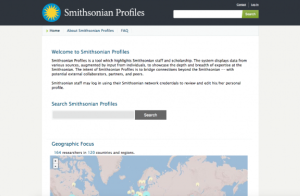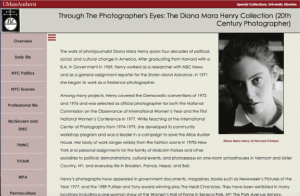General Interest
Back to Top
|
 |
|
Deep Carbon Observatory
|
Science |
|
The Deep Carbon Observatory (DCO) is an international community of approximately one thousand scientists dedicated to researching various aspects of carbon within the Earth across a wide range of disciplines. DCO's research is organized into four broad themes, each with a link on the main page: extreme physics and chemistry, reservoirs and fluxes, deep energy, and deep life. Scientists may like to explore DCO's data portal, which is a "searchable repository of data, datasets, and publications for helping to advance deep carbon science," as well as DCO's resources for early-career scientists. Science instructors may find their resources for educators helpful, which include downloadable modeling tools, educational videos, infographics, lectures, and webinars. Readers from all backgrounds may enjoy browsing content under DCO's science tab as well as their news section, which features hundreds of stories about DCO's decade of study. For example, in December 2018, DCO scientists reported that their research indicates the deep subterranean Earth contains far more life than previously believed, constituting "245 to 385 times greater than the carbon mass of all humans on the surface." Launched in 2009, DCO was established through seed funding from the Alfred P. Sloan Foundation. [JDC] |
|





|
|
 |
|
Smithsonian Profiles
|
Social studies |
|
With researchers and experts sprawling across its nineteen museums, nine research centers, and the National Zoo, the Smithsonian Institution has grown to become "the world's largest museum, education, and research complex." For the first time, the Smithsonian Institution has created a central, searchable directory of their scholarly experts. Launched in October 2018, Smithsonian Profiles is a tool that "outlines the expertise of current Smithsonian-affiliated scholars, connecting its audiences with curators, historians, researchers, and fellows who continually discover new knowledge to share worldwide." Visitors to Smithsonian Profiles can search this resource by keyword or use the interactive map on the main page to choose among the institution's numerous experts currently located in 120 countries and regions. Each researcher highlighted in Smithsonian Profiles has an individual profile page that includes information such as their research projects, educational background, a list of recent research publications, research grants, and awards. While the basic profiles are created automatically from the Smithsonian databases, scholars have the ability to add to their displayed information. As this new tool becomes more widely used, its value to both its visitors and the Smithsonian experts will become even greater. [JDC] |
|





|
|
 |
|
ORBIS: The Stanford Geospatial Network Model of the Roman World
|
Social studies |
|
Map aficionados, scholars, and general audiences alike may be interested in ORBIS: The Stanford Geospatial Network Model of the Roman World. This fascinating project is an interactive model of the Roman Empire that "reconstructs the time cost and financial expense associated with a wide range of different types of travel in antiquity," including movement by road, river, and sea with multiple travel modes available for each. ORBIS consists of 632 locations and covers approximately four million square miles of territory, creating a multi-modal network model of the Roman Empire that allows visitors to gain a more accurate understanding of how people, goods, and information flowed in ancient Rome. For new users, ORBIS provides an extensive introduction and tutorial explaining the research behind the model and how to use it to map routes between different locations. Visitors can also find examples of scholarly articles and working papers that incorporate ORBIS into their research. Users may also create their own maps, cartograms, or diagrams in ORBIS and export them as vector files. ORBIS was created collaboratively between an interdisciplinary team at Stanford University led by historian Walter Scheidel and digital humanities specialist Elijah Meeks. Visitors to this site may want to note that this site works best in Chrome and Safari browsers. [JDC] |
|





|
|
 |
|
Humanities for All
|
Social studies |
|
Across the United States, universities and colleges have been partnering with cultural institutions such as museums, historical societies, and state and local agencies to create publicly-engaged humanities projects. Humanities for All, a new initiative of the National Humanities Alliance Foundation, provides a database of over 1,500 public humanities programs throughout the country, showcasing a "wide range of humanities projects that engage with diverse publics as audiences and as partners." Visitors can search the database by keyword and filter the projects by the type of higher education institution, type of community partner, project theme, discipline, or state. Each cataloged public humanities project is categorized into at least one of the following groups: outreach, engaged research, engaged teaching, engaged public programming, and the infrastructure of engagement. About fifty projects have full profiles and the remaining have thumbnail descriptions, as well as links to every project's website. Humanities for All is based on a survey conducted in 2017-2018 and led by Daniel Fischer, a project director and postdoctoral fellow at the National Humanities Alliance Foundation. [JDC] |
|





|
|
 |
|
Through the Photographer's Eyes: The Diana Mara Henry Collection
|
Arts |
|
Photographer and photojournalist Diana Mara Henry documented many of the outstanding events of the late twentieth century in the US, from Vietnam War protests and the women's rights movement to the 1972 Democratic National Convention, as well as portraits of many prominent people, including politicians, musicians, activists, and artists. In the 1980s, Henry purchased 100 acres of land near Esopus Creek, a tributary of the Hudson River in Ulster County, New York, and began investigating food issues and the Permaculture Movement. Special Collections at the University of Massachusetts Amherst presents this web exhibition showcasing photographs and documents from their Diana Mara Henry Collection, such as Henry's press passes, articles, and reading lists for courses she took. Visitors to this site will also find information (all accompanied by photographs) about Henry's early and professional life, photographic assignments during political movements in New York City, and Henry's involvement in social movements throughout the 1970s and 80s. [DS] |
|





|
|














